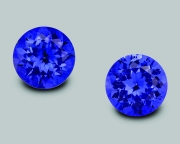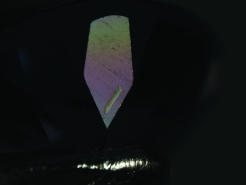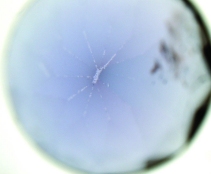FOR IMMEDIATE RELEASE
AGTA GTC and AGL IDENTIFY COATED TANZANITE.
NEW YORK, NY - 23 May 2008 - Recently the American Gem Trade
Association Gemological Testing Center (AGTA GTC) and American
Gemological Laboratories (AGL) received a number of faceted
tanzanite samples that were determined tobe coated. Evan Caplan of
Omi Gems, Inc. sent samples to several labs after a light
repolishing of a few stones resulted in a noticeable loss of color.
“Until now, we had not identified a coating on tanzanite to improve
its color.” indicated Dr. Lore Kiefert, Director of the AGTA GTC.
“Although the coating is not immediately obvious, careful
examination with a microscope and in immersion provided clear
indications of the coating in most instances.” stated Christopher P.
Smith, Vice President and Chief Gemologist of AGL. “This was
evidenced by abrasions along facet junctions and at the culet where
the coating had worn off, as well as a subtle iridescence when
viewing the surface with reflected light.” Smith further added.
Advanced analytical testing identified that the coating was composed
at least in part to cobalt. “The most reliable means to substantiate
the presence of the coating is with the use of X-ray fluorescence
spectroscopy.” Kifert explained “The coating is colored by cobalt,
which is readily detected using this analytical technique.”
Although the gemstone industry has become very familiar with the
practice of heating zoisite to achieve the best violet to blue color
in tanzanite, these stones represent the first time either lab has
identified a coating on tanzanite to further improve its color.
The majority of the tanzanite sample was comprised of smaller
calibrated stones. Fine color tanzanite in this size range is rarely
sent to a lab and therefore would avoid detection unless closely
scrutinized. “This is just a further reminder that each and every
gemstone should be fully examined to determine whether or not it has
been treated.” Smith indicated “Today, it is not uncommon to see
stones that have been treated using multiple orcompound techniques
to achieve a particular result.”
As a closing statement, both Kiefert and Smith emphasized “Any
treatment used to modify the color of a gem should be disclosed.
Coatings in particular are not considered permanent and in the U.S.
are required by FTC guidelines to be properly disclosed at the point
of sale.”
Figure 1: These two tanzanites were part of a group of stones
recently examined at both the AGTA GTC and AGL facilities in New
York. Both were identified as having a thin coating layer to
artificially improve their color. Photograph by Fred Kahn and Sun
Joo Chung.
Figure 2: The cobalt-coating produced a subtle iridescence that
could be seen when observing the stone’s surface in reflected light.
The rectangular area near the point of this facet also highlights an
area on the host tanzanite where the coating did not adhere.
Photomicrograph by Christopher P. Smith
Figure 3: In immersion it was also noted that along facet junctions
and at the culet the color was lighter. This was a result of where
the coating had been abraded away, revealing the lighter, inherent
color of the tanzanite. Photomicrograph by Christopher P. Smith


